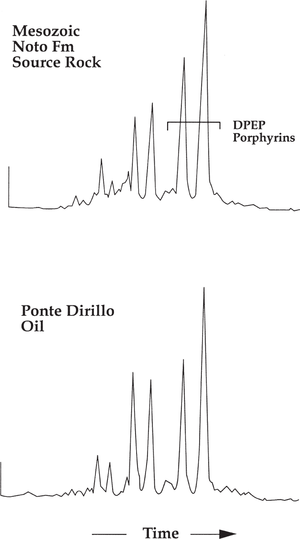Porphyrins and high-performance liquid chromatography (HPLC)
(Redirected from High-performance liquid chromatography)
Jump to navigation
Jump to search
| Exploring for Oil and Gas Traps | |

| |
| Series | Treatise in Petroleum Geology |
|---|---|
| Part | Critical elements of the petroleum system |
| Chapter | Oil–oil and oil–source rock correlations |
| Author | Douglas W. Waples, Joseph A. Curiale |
| Link | Web page |
| Store | AAPG Store |
Porphyrins in crude oil are large, complex molecules derived primarily from chlorophyll and related compounds. They are found in virtually all oils and rock extracts, with the exception of condensates that have lost their heavy ends. Porphyrins are separated by HPLC and can be analyzed by several different methods.
Example
Figure 1 shows a comparison of nickel porphyrin distributions for a source rock extract (top) and an oil (bottom) from southern Sicily. The similar porphyrin distributions for the oil and the source rock extract suggest a plausible positive correlation, which in this case was supported by other geochemical data.

Figure 1 Comparison of nickel porphyrin distributions for a source rock extract (top) and an oil (bottom) from southern Sicily. From Ocampo et al.;[1] reprinted by permission from American Chemical Society.
See also
- Molecular parameter data for oil–oil and oil–source rock correlations
- Gas chromatography: data obtained
- Gas chromatography/mass spectrometry (GC/MS): procedures
- Organic compounds: environmental indicators
- Gas chromatography/mass spectrometry (GC/MS): examples of correlations
- Gas chromatography/mass spectrometry (GC/MS): limitations
- Oil-oil and oil-source rock correlation
References
- ↑ Ocampo, R., A. Riva, J. M. Trendel, J. Riolo, H. J. Callot, and P. Albrecht, 1993, Petroporphyrins as biomarkers in oil-oil and oil-source rock correlations: Energy & Fuels, vol. 7, p. 191–193, DOI: 10.1021/ef00038a005.